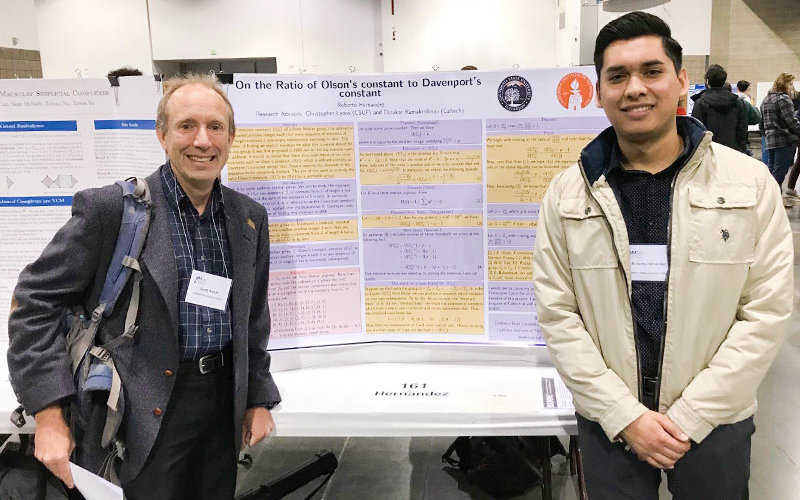
Mathematics major Roberto Hernandez is studying group theory, a subject that captures mathematical aspects of symmetry and has applications in many areas of math and science. For example, it can explain certain properties of molecules in chemistry, properties of elementary particles in physics and can even help solve a Rubik’s cube.
Classmate William “Bill” Terry is focusing his mathematics research on quotients, which is a way of grouping together parts of a space, with each group a single point, in much the same way zooming out in Google Maps will present an entire city as a single dot.
Terry is examining certain quotients and exploring the abstract shape of the result, determining what is called the topology. In addition to finding some surprising and bizarre topologies this way, the spaces he has found have some deep connections to important and ubiquitous objects in physics — like spacetime itself, noted his research adviser Matthew Rathbun, assistant professor of mathematics.
For their research presentations, Hernandez and Terry each received a Mathematical Association of America Outstanding Student Poster award at the recent Joint Mathematics Meetings in Denver. The undergraduate researchers competed against more than 600 peers from such institutions as MIT, Harvard University, UC Berkeley and UCLA.
The national meeting brought together the Mathematical Association of America, American Mathematical Society, Association of Women in Mathematics and Society for Industrial and Applied Mathematics.
A first-generation college student, Hernandez is on track to graduate in May and is a scholar in the university’s Graduate Readiness and Access in Mathematics program for students aspiring to earn a graduate degree in math. He plans to start the doctoral program in mathematics at Emory University this fall.
Hernandez, whose research adviser is Christopher Lyons, assistant professor of mathematics, wants to teach at the university level to encourage underrepresented students like himself to study STEM (science, technology, engineering and mathematics) disciplines.
“I care very much about making the field a more inclusive environment and believe in the idea that everybody has the ability to do good math,” Hernandez said. “My career goal is to try and reach as many underrepresented students as possible. I would like to present them with the same opportunities I have been given to help diversify the field.”
Terry, a double major in mathematics and physics, plans on a career combining both disciplines, specifically how math concepts like topology and group theory relate to physics. He plans to graduate in May and has applied to doctoral programs.
After taking advanced calculus and doing research with Rathbun, the complexity of the material made Terry interested in learning more about math.
“It takes a bit to see the beauty of math, but once you start to see it, you can’t go back,” he said.
Math Researchers Shine
Four other math students earned honorable mentions for their research presentations: Alexandro Luna (Zair Ibragimov, professor of mathematics, faculty adviser); Gustavo Sopena (Roberto Soto, assistant professor of mathematics, faculty adviser); and Jasmine Camero and Danielle Sebring, who were mentored by faculty in their 2019 summer Research Experiences for Undergraduates programs, funded by the National Science Foundation. Camero conducted research at Brown University and Sebring at Carnegie Mellon University.
Other students who presented their math research at the meeting are: Cameron Hooper (Laura Smith Chowdhury, associate professor of mathematics); Erica Ward (Nicholas D. Brubaker, assistant professor of mathematics); Gustavo Sopena and Sonali Vyas (Soto); and Lamson Nguyen (Rathbun).
Additionally, mathematics faculty organized special sessions at the meeting: Scott Annin and Bogdan Suceavă, both professors of mathematics, on “How to Discover and Train Gifted Students;” Suceavă, Brubaker and Thomas Murphy, assistant professor of mathematics, on “Differential Geometry and Global Analysis;” and Ibragimov on “International Research Experiences for Students.”